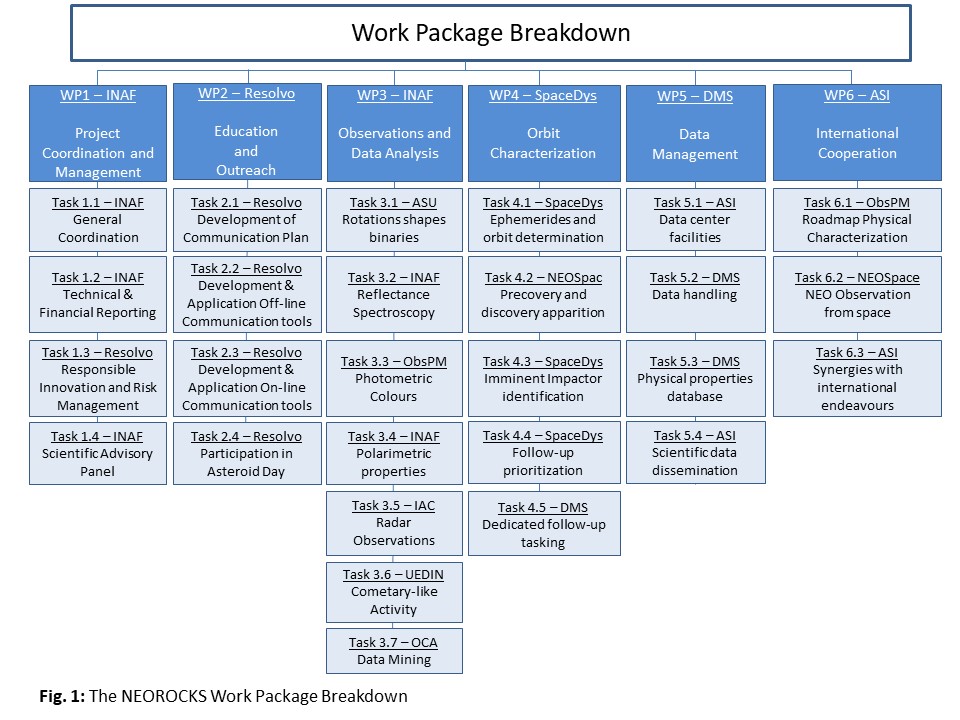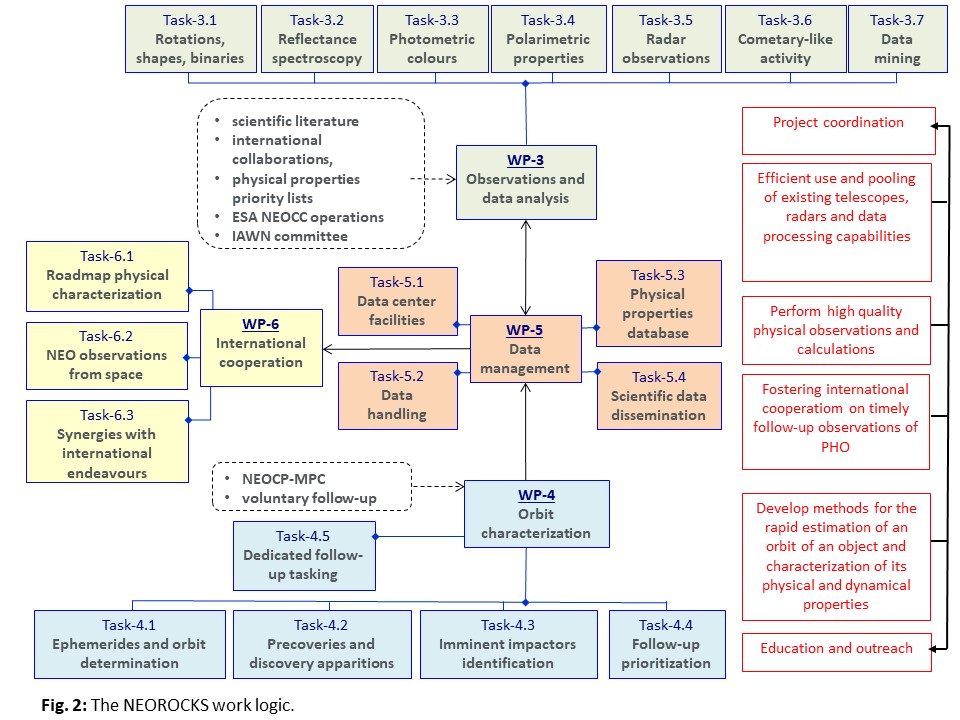- 1INAF-Osservatorio Astronomico di Roma, Monte Porzio Catone (Roma), Italy (elisabetta.dotto@inaf.it)
- 2NEOSPACE sp. z o.o., PL
- 3Resolvo s.r.l., I
- 4LESIA – Observatoire de Paris, F
- 5Space Dynamics Services s.r.l., I
- 6IMCCE – Observatoire de Paris, F
- 7Observatoire de la Côte d’Azur, F
- 8INAF – Osservatorio Astrofisico di Torino, I
- 9Instituto de Astrofisica de Canarias, S
- 10Università di Padova, I
- 11DEIMOS Space, S
- 12DEIMOS Castilla La Mancha sl, S
- 13ASI-Agenzia Spaziale Italiana, I
- 14Astronomicky Ustav AV CR, CZ
- 15University of Edinburgh, UK
- 16DEIMOS Space s.r.l., RO
- *A full list of authors appears at the end of the abstract
The knowledge of even some basic physical properties of a NEO such as the composition and the internal structure has strong implications for both science and impact mitigation. Depending on its composition and internal structure a meter-size object can completely burn in the atmosphere or reach the ground excavating an impact crater. To date, only 20% of the known NEO population has been characterized. The percentage rises 30% when considering only objects larger than 1 km. The reason is that physical characterization requires availability of large aperture telescopes, accurate ephemerides, and can be performed only if the object is sufficiently bright.
International efforts devoted to NEO physical characterization have undoubtedly succeeded in the last decade in addressing this problem through the organization of extensive observational campaigns within the framework of international cooperative programs. Yet the observational work and the associated modelling and simulation research is far from being exhausted in particular as far as the physical characterization of PHOs and smaller objects (D<140 m) passing close or colliding with the Earth are concerned.
The aim of the NEOROCKS project is to look at the 2020 horizon and beyond, by proposing an innovative approach that takes into consideration the incoming operations of the next generation sky surveys (with wide-field high-sensitivity telescopes), which will dramatically change the NEO discovery scenario.
The Project
NEOROCKS utilizes an innovative approach focused on:
- a) performing high-quality physical observations and related data reduction processes;
- b) investigating the strong relationship between the orbit determination of newly discovered objects and the quick execution of follow-up observations in order to face the threat posed by the “imminent impactors”;
- c) profiting of the European industrial expertise in on-going Space Situational Awareness initiatives to plan and execute breakthrough experiments foreseeing the remote tasking of highly automatized robotic telescopes, in order to provide a proof-of-concept rapid-response system;
- d) guarantee extremely high standards in the data dissemination through the involvement at agency level of a data center facility already operating in a European and international context.
The key issue, which marks the radical difference of this approach, is the early onset (from discovery) of a direct link between orbital and physical characterization. Our process continuously analyses the new published detections, in order to find out those which deserve attention as potentially hazardous. For each object identified, the astrometric follow-up and the associated orbit improvements are activated in closed loop until the accuracy of the ephemerides enables successful attempts of observations devoted to physical characterization. Speeding up this process, to complete it within the typical period of visibility of a newly discovered object in the vicinity of our planet (days to weeks), provides an innovative pre-operational scenario for addressing the “imminent impactors” threat. This is particularly relevant since small objects in route of collision with the Earth are likely to be routinely discovered by the new generation NEO sky surveys. Therefore, our approach aims to introduce an entirely new methodology into future operational NEO hazard monitoring systems.
The introduction of novel methods for orbit determination and for the prioritization of follow-up observations are at the core of our approach. To assess performances that it can reach, a real-time telescope tasking experiment is envisaged as a test case scenario with the potential to scale up to a global level.
Observation campaigns focussed on already known objects and the associated data reduction and analysis are also performed throughout the project, in order to provide high-quality data on specific interesting targets for science and mitigation. This goal is achieved thanks to the participation of astronomical institutions and observatories that can access top-class instrumentation (e.g. 3-10m aperture telescopes) and to perform challenging radar observations within the framework of international collaborations.
NEOROCKS also sets up necessary infrastructure to store, maintain and disseminate data produced and tools developed, well beyond the nominal lifetime of the project, thus granting the continuation of its approach and the update of its results. This is achieved through partnership with ASI Space Science Data Centre (SSDC https://www.ssdc.asi.it/), which is equipped with necessary HW/SW environment.
Team and activities
The main subject of NEOROCKS is to boost the NEO follow-up observations scenario devoted to determine the parameters characterizing asteroid properties, such as composition, shape, spin and mass: these quantities are relevant for our understanding of the nature of NEOs and the potential hazard they pose to human beings.
Another fundamental activity is focused in orbit determination and data management: special attention will be given to the timely detection and characterization of small potential imminent impactors of the Earth, which are likely to represent the next real threat.
Fig. 1 shows the Work Package Breakdown and Fig. 2 the Work Logic.


NEOROCKS has the potential to perpetuate the approach followed during the project and the results obtained, through the in-kind contribution of the ASI-SSDC in hosting the project products. The possibility of profiting from a well-established facility devoted to science data exploitation after the project is finished ensures a high-level dissemination toward the scientific and technological communities involved in NEO research as well as to the public at large.
The NEOROCKS team includes also industrial partnerships actively participating to European Space Awareness programmes. The goal of this activity is to probe the engagement of European and international partners in a proactive contribution to the detection of NEO potential threats, as well as to the planning and implementation of effective mitigation measures in a highly synergic and complementary scenario.
Acknowledgements. This project has received funding from the European Union’s Horizon 2020 research and innovation programme under grant agreement No 870403.
S. Anghel, A. Bertolucci, F. Calderini, F. Colas, A. Del Vigna, A. Dell’Oro, A. Di Cecco, L. Dimare, P. Fatka, S. Fornasier, E. Frattin, P. Frosini, M. Fulchignoni, R. Gabryszewski, M. Giardino, A. Giunta, T. Hromakina, J. Huntingford, S. Ieva, J.P. Kotlarz, F. La Forgia, J. Licandro, H. Medeiros, F. Merlin, F. Pina, G. Polenta, M. Popescu, A. Rozek, P. Scheirich, A. Sergeyev, A. Sonka, G.B. Valsecchi, P. Wajer, A. Zinzi.
How to cite: Dotto, E., Banaszkiewicz, M., Banchi, S., Barucci, M. A., Bernardi, F., Birlan, M., Carry, B., Cellino, A., De Léon, J., Lazzarin, M., Mazzotta Epifani, E., Mediavilla, A., Nomen Torres, J., Perna, D., Perozzi, E., Pravec, P., Snodgrass, C., and Teodorescu, C. and the NEOROCKS team: The EU Project NEOROCKS — NEO Rapid Observation, Characterization, and Key Simulations Project, Europlanet Science Congress 2021, online, 13–24 Sep 2021, EPSC2021-389, https://doi.org/10.5194/epsc2021-389, 2021.

